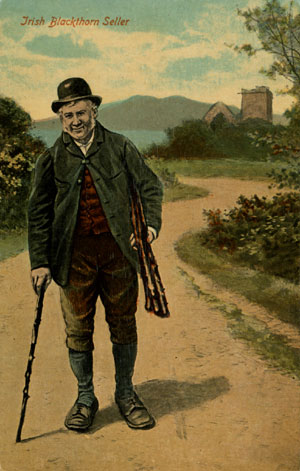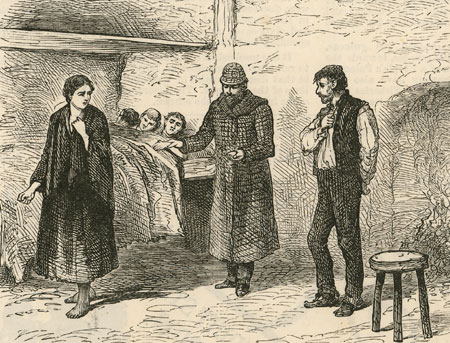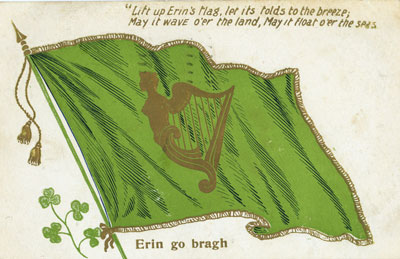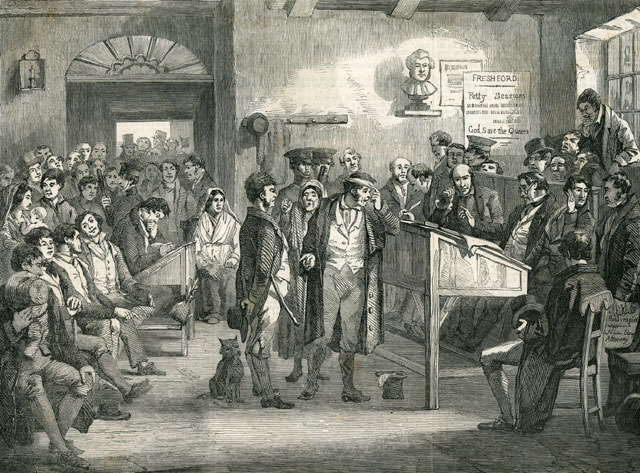
The blackthorn walking stick (or Shillelagh) is cut from the sloe bush. It was once more a weapon than a walking stick. In Irish folklore it was believed that the fairies or "little people" lived in Blackthorn bushes.
| Odd Bits |
| WALSH/LANGAN INTRODUCTION |
| HOME |
 |
Irish Blackthorn Seller The blackthorn walking stick (or Shillelagh) is cut from the sloe bush. It was once more a weapon than a walking stick. In Irish folklore it was believed that the fairies or "little people" lived in Blackthorn bushes. |
| Postcard collection of Maggie Land Blanck, Not posted | |
 |
The Doctor on His Rounds: visiting Fever Patients The Illustrated London News, Apri 24, 1886 |
|
Photo collection of Maggie Land Blanck
| |
 |
|
|
Postcard collection Maggie Land Blanck Posted 1908 from Ontario, Canada to Buffalo, NY Green was a simple of revolution in the late 18th century. An unofficial Irish flag with a green background and a gold harp served from 1798 to the early twentieth century as a symbol of Irish nationalism. Associated with the Fenian movement in the 1860s it was also used by the supporters of Home Rule from Parnell's time to the fall of the Irish Parliamentary Party in 1918. In many instances Erin Go Bragh (Ireland forever) was printed on the flag under the harp. This version includes the ancient Irish goddess, Eire, instead of just a simple gold harp.
| |
 | |
| The Illustrated London News, 1853, collection of Maggie Land Blanck
Irish Petty Sessions
February 12, 1853 A local court hearing a complaint between two individuals where one accuses the other of beating him up. The accused was find 5 shillings for misconduct. Petty Sessions were the lowest court in the land. | |
| Names - First Bridget One of the most common female names in Ireland. Almost every family in Ireland had a Bridget. However, the name was less used by the Irish American immigrants. Pet forms of Bridget were: Bride, Dideia, Delia, Beesy, Biddy. Biddy was the name usually given for the "typical" Irishwoman of the lower class.
Ellen Ellen, Eileen, Nellie, Nell, Helen, Ellie and Ella are all variations of the same name.
Maggie Maggie was a common Irish nickname for Margaret. It Irish for Margaret was Mairead. Penelope (Nappy) Finnguala (f'un-ual-a) "fair shouldered" popular in Ireland until the late middle ages. Almost obsolete since the beginning of the 18th century. The name has been anglicized as Flora, Penelope, Penny, Nappy and Fenella. Nappy was popular in the west of Ireland among Irish speakers in the late 19th and early 20th centuries.
|
| If you have any suggestions, corrections, information, copies of documents, or photos that you would like to share with this page, please contact me at maggie@maggieblanck.com | |||
| The Potato and Other Crops | |||
| Houses | |||
| Turf | |||
| Transportation | |||
| Religion and Believes | |||
| JOHN WALSH | |||
| MATHIAS LANGAN | |||
| WALSH/LANGANS INTRODUCTION | |||
| HOME | |||
| Irish Life | |||
|
Please feel free to link to this web page. You may use images on this web page provided that you give proper acknowledgement to this web page and include the same acknowledgments that I have made to the provenance of the image. Please be judicious. Please don't use all the images. You may quote up to seventy five words of my original text from this web page and use any cited quotes on this web page provided you give proper acknowledgement to this web page and include the same acknowledgments that I have made to the provenance of the information. Please do not cut and paste the whole page. You may NOT make use any of the images or information on this web page for your personal profit. You may NOT claim any content of this web page as your original idea. Thanks, Maggie |
| ©Maggie Land Blanck - page created 2004 - latest update, August 2013 |